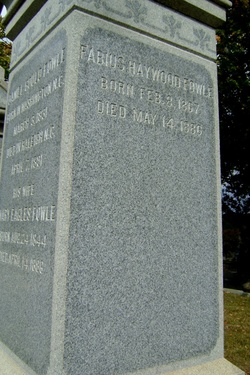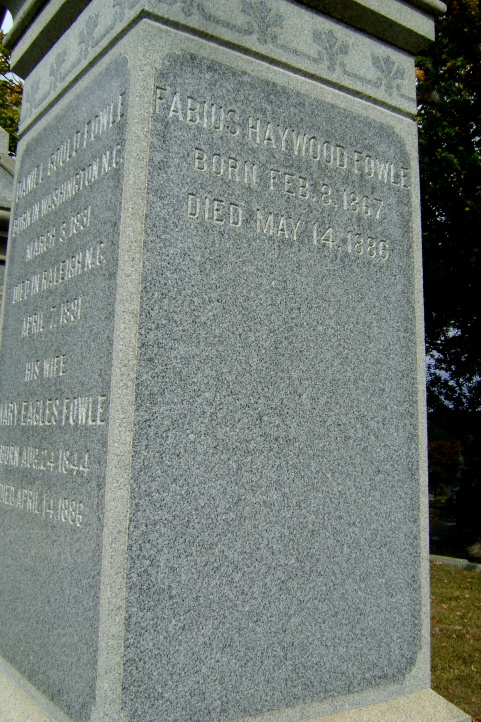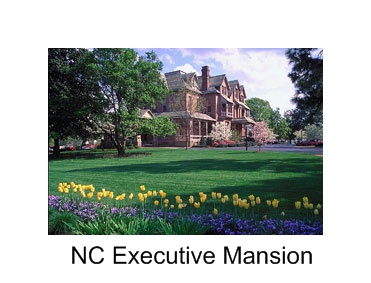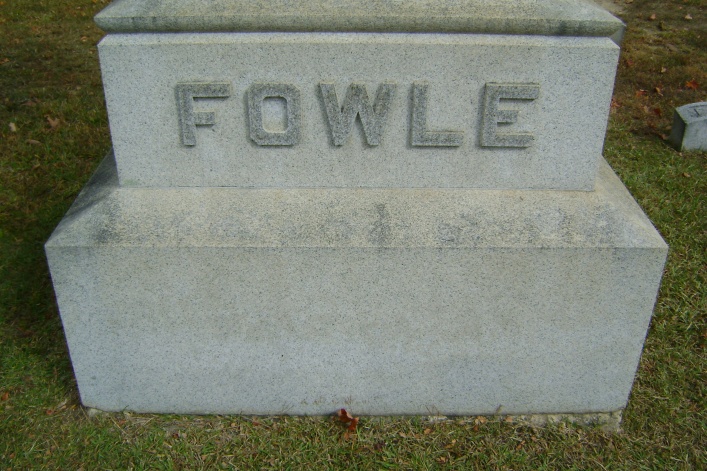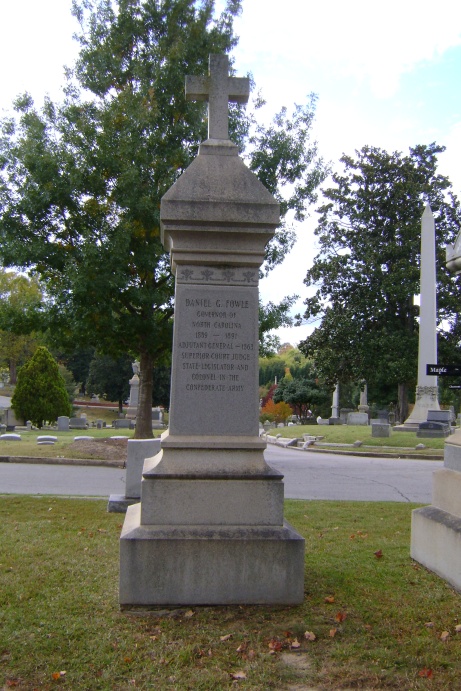He was the paternal grandchild of Samuel Richardson Fowle of Woburn, MA who came to Beaufort, Washington Co, NC ca. 1820 and married Martha Barney Marsh. He is a direct descendant of this family's patriarch, George Fowle (1610-1682) born in Sandhurst, Kent Co, England and Mary Tufts (1613-1678) of England who came to Concord, Middlesex Co, MA ca. 1640. On his mother's side, he was the maternal grandson of Dr. Fabius J. Haywood & Martha Helen Whitaker of Raleigh.
Fab's father had married (1st) Ellen Brent Pearson in 1856, and by her had 4 children. Ellen died in 1862 and his father married his mother, Mary Eagles Haywood, in 1866.
His mother died on April 14, 1886 when he was 19 years old. Exactly 30 days later, Fab was killed in a hunting accident and died on May 14, 1886. His bereaved father was said never to have recovered from his grief of losing his wife and son so close together.
Two years after Fab's death, in 1888, his widowed father was elected Governor of North Carolina. During his tenure, the North Carolina Executive Mansion was being built, and was completed in 1891. The home, still used by North Carolina Governors, is considered a fine example of the Queen Anne style of Victorian architecture. No detail was overlooked. Its many attractive features include a steeply pitched gable, richly colored textural surfaces, and elaborate turned woodwork. Construction of the mansion was supervised by the warden of the prison, Col. William J. Hicks. The use of convict labor was not new to state projects. The bricks for the house and sidewalks were made by prison labor from clay minded in Wake County. If you look closely at the bricks, you can see names of prisoners inscribed in the bricks.
The Governor's Mansion was so expensive to build and so lavish that Governor Fowle was afraid the NC legislature would repurpose the building after its completion. So, the Governor and his family, moved into the building in January 1891, before it was finished. Four months later on April 7, 1891, the Governor died suddenly while still in office. According to popular legend, the ghost of Gov. Fowle still haunts the executive mansion.
He was the paternal grandchild of Samuel Richardson Fowle of Woburn, MA who came to Beaufort, Washington Co, NC ca. 1820 and married Martha Barney Marsh. He is a direct descendant of this family's patriarch, George Fowle (1610-1682) born in Sandhurst, Kent Co, England and Mary Tufts (1613-1678) of England who came to Concord, Middlesex Co, MA ca. 1640. On his mother's side, he was the maternal grandson of Dr. Fabius J. Haywood & Martha Helen Whitaker of Raleigh.
Fab's father had married (1st) Ellen Brent Pearson in 1856, and by her had 4 children. Ellen died in 1862 and his father married his mother, Mary Eagles Haywood, in 1866.
His mother died on April 14, 1886 when he was 19 years old. Exactly 30 days later, Fab was killed in a hunting accident and died on May 14, 1886. His bereaved father was said never to have recovered from his grief of losing his wife and son so close together.
Two years after Fab's death, in 1888, his widowed father was elected Governor of North Carolina. During his tenure, the North Carolina Executive Mansion was being built, and was completed in 1891. The home, still used by North Carolina Governors, is considered a fine example of the Queen Anne style of Victorian architecture. No detail was overlooked. Its many attractive features include a steeply pitched gable, richly colored textural surfaces, and elaborate turned woodwork. Construction of the mansion was supervised by the warden of the prison, Col. William J. Hicks. The use of convict labor was not new to state projects. The bricks for the house and sidewalks were made by prison labor from clay minded in Wake County. If you look closely at the bricks, you can see names of prisoners inscribed in the bricks.
The Governor's Mansion was so expensive to build and so lavish that Governor Fowle was afraid the NC legislature would repurpose the building after its completion. So, the Governor and his family, moved into the building in January 1891, before it was finished. Four months later on April 7, 1891, the Governor died suddenly while still in office. According to popular legend, the ghost of Gov. Fowle still haunts the executive mansion.
Family Members
Advertisement
Explore more
Sponsored by Ancestry
Advertisement
